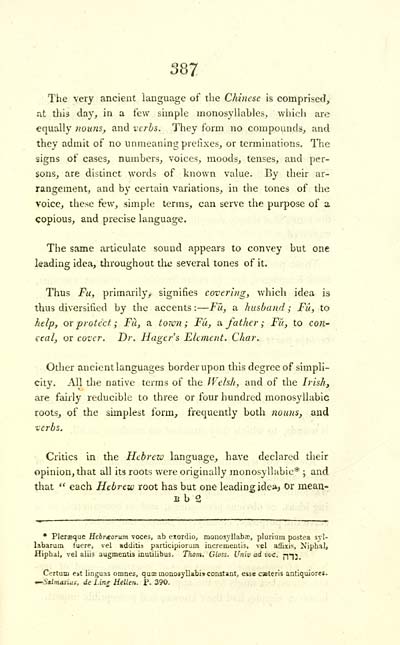Blair Collection > Celtic researches, on the origin, traditions & language, of the ancient Britons
(481)
Download files
Complete book:
Individual page:
Thumbnail gallery: Grid view | List view

387
The very ancient language of the Chinese is comprised,
at this day, in a tew simple monosyllables, which are
equally nouns, and verbs. They form no compounds, and
they admit of no unmeaning prefixes, or terminations. The
signs of cases, numbers, voices, moods, tenses, and per-
sons, are distinct words of known value. By their ar-
rangement, and by certain variations, in the tones of the
voice, these few, simple terms, can serve the purpose of a
copious, and precise language.
The same articulate sound appears to convey but one
leading idea, throughout the several tones of it.
Thus Fu, primarily^ signifies covering, which idea is
thus diversified by the accents : — Fu, a husband ; Fu, to
help, or protect ; Fu, a town; Fa, & father ; Fu, to con-
ceal, or cover. Dr. Hager's Element. Char.
Other ancient languages border upon this degree of simpli-
city. All the native terms of the Welsh, and of the Irish,
are fairly reducible to three or four hundred monosyllabic
roots, of the simplest form, frequently both nouns, and
verbs.
Critics in the Hebrezu language, have declared their
opinion, that all its roots were originally monosyllabic* ; and
that " each Hebrew root has but one leading ideaj Or mean-
B b 2
* PleraBque Hcbrxorum voces, ab exordio, monosyllabas, plurium postoa syl-
labarum fucre, vel additis participiorum incrementis, vel affixis, Niphal,
Hiphal, vel aliis augmeutis inutilibus. Thorn. Gloss. Univ ad vvc. f|"i3.
Certum est linguas omnes, qua monosyllabi» constant, esse cseteris antiquiores.
■mmSalmasius, de Ling Hellm. i». 390.
The very ancient language of the Chinese is comprised,
at this day, in a tew simple monosyllables, which are
equally nouns, and verbs. They form no compounds, and
they admit of no unmeaning prefixes, or terminations. The
signs of cases, numbers, voices, moods, tenses, and per-
sons, are distinct words of known value. By their ar-
rangement, and by certain variations, in the tones of the
voice, these few, simple terms, can serve the purpose of a
copious, and precise language.
The same articulate sound appears to convey but one
leading idea, throughout the several tones of it.
Thus Fu, primarily^ signifies covering, which idea is
thus diversified by the accents : — Fu, a husband ; Fu, to
help, or protect ; Fu, a town; Fa, & father ; Fu, to con-
ceal, or cover. Dr. Hager's Element. Char.
Other ancient languages border upon this degree of simpli-
city. All the native terms of the Welsh, and of the Irish,
are fairly reducible to three or four hundred monosyllabic
roots, of the simplest form, frequently both nouns, and
verbs.
Critics in the Hebrezu language, have declared their
opinion, that all its roots were originally monosyllabic* ; and
that " each Hebrew root has but one leading ideaj Or mean-
B b 2
* PleraBque Hcbrxorum voces, ab exordio, monosyllabas, plurium postoa syl-
labarum fucre, vel additis participiorum incrementis, vel affixis, Niphal,
Hiphal, vel aliis augmeutis inutilibus. Thorn. Gloss. Univ ad vvc. f|"i3.
Certum est linguas omnes, qua monosyllabi» constant, esse cseteris antiquiores.
■mmSalmasius, de Ling Hellm. i». 390.
Set display mode to: Large image | Transcription
Images and transcriptions on this page, including medium image downloads, may be used under the Creative Commons Attribution 4.0 International Licence unless otherwise stated. ![]()
| Early Gaelic Book Collections > Blair Collection > Celtic researches, on the origin, traditions & language, of the ancient Britons > (481) |
|---|
| Permanent URL | https://digital.nls.uk/75769186 |
|---|
| Description | A selection of books from a collection of more than 500 titles, mostly on religious and literary topics. Also includes some material dealing with other Celtic languages and societies. Collection created towards the end of the 19th century by Lady Evelyn Stewart Murray. |
|---|
| Description | Selected items from five 'Special and Named Printed Collections'. Includes books in Gaelic and other Celtic languages, works about the Gaels, their languages, literature, culture and history. |
|---|

